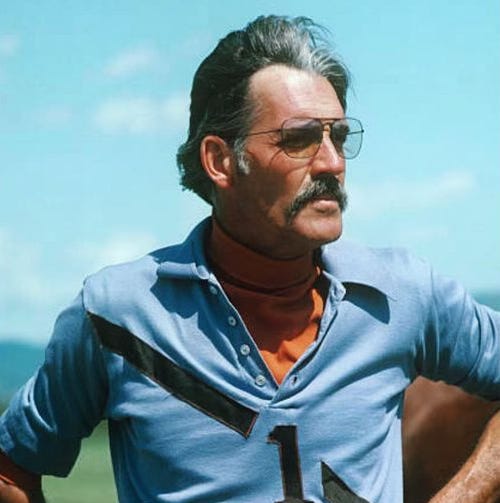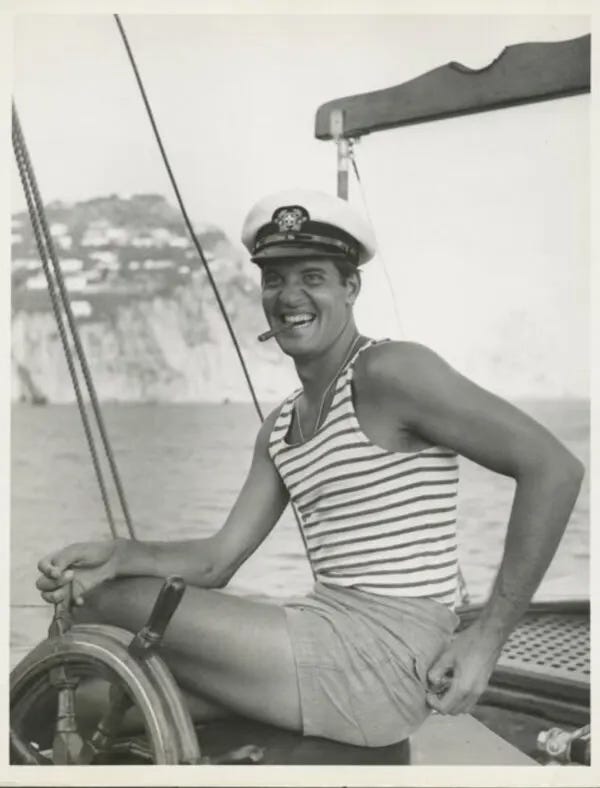
Michael Butler is best known as the producer of the revolutionary musical “Hair,” a defining work of the 1960s counterculture. Despite no prior experience, he was captivated by its revolutionary message and brought it to Broadway, where it became a cultural phenomenon. Michael’s contributions extended beyond theater, as he also contributed to founding many important discotheques in North America and the Talisman Resort on Fire Island.
Table of Contents: Early Life and Family Background / Education / From Chicago to NYC / Hair’s Impact on the 60s Counterculture / Personal Life / Later years
If you aren’t subscribed yet, hit the subscribe button below to receive the Adorable Stories every weekend, directly in your inbox:
Early Life and Family Background
Born on November 26th, 1926, Michael Butler came from a wealthy family in Chicago. His father, Paul Butler, was a prominent businessman, and the family had interests in various industries, including paper manufacturing, aviation and horse racing.
The Butler family also owned 5,800 acres outside Chicago, land that is now the village of Oak Brook, Illinois, and they would host polo tournaments, skeet shoots and fox hunts there.
His Anglo-Irish family first arrived in America in 1654. In the early 1800s, his ancestors Asa and Simon Butler were the first American paper makers to make paper for the U.S. Congress. In the 1830s, Oliver Morris Butler built a paper mill on the Fox River in Illinois. In 1841, his brother Julius Wales Butler founded the J.W. Butler Paper Company on State Street in Chicago, IL., the oldest family owned business in Chicago. They also were the largest landowners in Du Page County.

Michael’s father, Paul Butler had business interests in aviation, real estate, and the paper industry. The family also owned a significant horse racing stable, which became one of their notable enterprises. Their diverse investments provided a strong financial foundation, allowing Michael to pursue his passion for theater and the arts.
Education
Michael attended various schools growing up, including the Culver Military Academy in Indiana, and studied English and history for a time at the University of Colorado before dropping out to spend nine months travelling across Africa, where, he said, he “drove a station wagon from Cape Town to Khartoum.”
Michael also tried the University of Virginia, where he hoped to pursue architecture, but, as he told The Honolulu Advertiser in 1974, “I got interested in fox hunting, and that was it.”
He then went to work for his father helping to run the various family businesses, and he showed some talent.
In 1962, President John F. Kennedy made him a special adviser on the Middle East, where Mr. Butler had been overseeing the family business interests.
In the early 1960s, Michael founded Talisman, a resort community on Fire Island, together with the record executive Ahmet Ertegun (whom we already mentioned in the Adorable Story #75 about Chessy Rainer, friend and business partner of Ahmet’s wife, interior designer Mica Ertegun): for some time in the 60s, Talisman was the place to be for the chic and well heeled.
Michael Butler was also partner in various discothèques (including Inferno, Ondine, Hippopotamus (which we mentioned in the Adorable Story #80 about Olivier Coquelin), and LeBison), among other interests.
He also managed the polo club the family founded at Oak Brook, even getting Prince (now King) Charles to play there in 1986 with a British team.
“Inheritance is a dangerous thing,” Mr. Butler told The Boston Globe in 1979, explaining his ever-expanding lists of interests and investments: “The temptation is to goof off and not struggle.”
From Chicago to NYC
Michael Butler’s journey from Chicago to New York was driven by his passion for the arts and a desire to make an impact. Despite having no prior experience with musicals, Michael was captivated by the cultural shifts of the 1960s.
His background in business and his family’s financial support provided him with the resources and confidence to take on this ambitious project, ultimately leading to the show’s monumental success.
Michael had seen the original Off Broadway version of “Hair,” produced by Joseph Papp at the Public Theater in 1967, and decided he was the person to take it to Broadway, but not without some changes.
He thought the downtown version of the show was too “beatnik.”
“Beatnik is put-down, negative, drag,” he explained to The Los Angeles Times in 1969. “Hippie is put-on, positive, beautiful.”
The reworked version added the now-famous nude scene involving assorted cast members at the end of the first act, startling for Broadway at the time.
Hair’s Impact on the 60s Counterculture
“I think this is the first public platform for the hippie movement,” he told Newsday in 1968. “It really describes the hippie movement in the hippie way and communicates it to non-hippies.”
When Michael Butler took “Hair” to Broadway, he worked closely with the creative team to refine the production. He helped reshape the musical to better resonate with mainstream audiences while maintaining its original spirit.
This included enhancing the choreography and updating the set design to create a more dynamic and engaging experience. Butler’s vision and input were instrumental in transforming “Hair” into the iconic Broadway hit it became: the show was a massive success, running for 1,750 performances and earning a Tony Award nomination.
He also established a dozen road companies that performed the show throughout North America and overseas. A few times, with one company or another, he even joined the cast members during the now famous nude scene.
“I certainly wouldn’t like to run around nude all the time,” he told The Palm Beach Post in 1972, “but it’s nice to have the freedom to do it if you want to.”

“Butler, who is driven about in an antique Rolls-Royce, feels he’s a hippie,” the Long Island newspaper Newsday wrote in 1968, two months after “Hair” opened on Broadway. “He even looks like a hippie, in leather jacket, bushy mustache and long hair. But the jacket cost a bundle from an exclusive men’s shop in town.”
Personal Life
Michael Butler was married three times before he was 40, to Marti Stevens, Robin Boyer and Loyce Stinson Hand: all three marriages ended in divorce.
He was linked romantically to a number of partners over the years, including actress Audrey Hepburn in the 1950s.
Throughout his life, Michael Butler has lived in Oak Brook, New York City, Belerbei (Turkey), Montecito, Los Angeles, Warfield, and Berks (UK).
Later years
Michael accumulated a few more Broadway producing credits, most notably on “Lenny,” a 1971 play based on the life of Lenny Bruce that ran for more than a year, and the musical “Reggae” in 1980.
He also produced a number of productions of “Hair” in addition to the original road company ones, including a 1977 Broadway revival.
In the early 1990s, Michael Butler declared bankruptcy, blaming soured investments and family infighting over the Butler fortune.
In a 1993 interview with The New York Times, he reflected on materialism, his reduced circumstances and the lessons of “Hair.”
“You can’t forget the dreams and the hopes and the thoughts of peace and love that went on in the 1960s,” he said. “They were beautiful things. Something will happen to bring the Age of Aquarius about. I believe that.
“It may be a collective feeling,” he added. “It may be a messiah, although, whenever I say that, I always add that I’m not a candidate for the job.”
Michael Butler died on November 7th, 2022 in Reseda, California. He was 95 years old.
“Hair” continues to be performed frequently around the world, and he was said to be working on a new production at the time of his death.
—Alberto @
Do you know anyone who would love to read this Adorable Story? Show your support by sharing Adorable Times’ Newsletter and earn rewards for your referrals.










